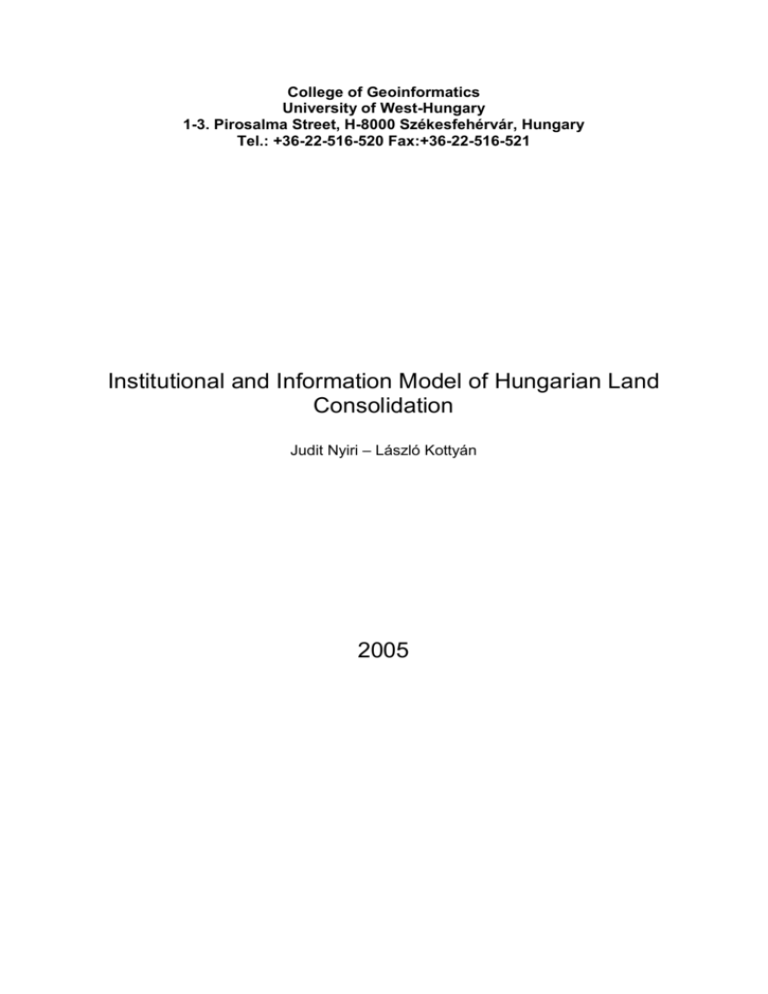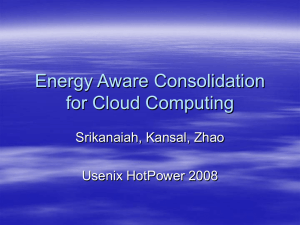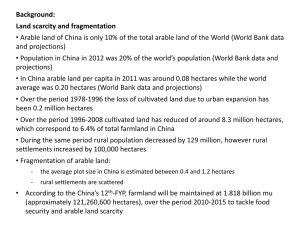Institutional and Information Model of Hungarian Land Consolidation
advertisement

College of Geoinformatics University of West-Hungary 1-3. Pirosalma Street, H-8000 Székesfehérvár, Hungary Tel.: +36-22-516-520 Fax:+36-22-516-521 Institutional and Information Model of Hungarian Land Consolidation Judit Nyiri – László Kottyán 2005 1. Introduction The privatisation of the agricultural lands in Hungary has practically been completed by now, resulting in a heavily fragmented property structure, in which the land properties are scattered in space. The socio-economic changes of the 1990s brought a significant turn to the consolidated land policy of the last 2-3 decades, in which the agricultural sector achieved internationally recognized results. The radical reorganization in properties and land use aimed to restore the leading role of private ownership, to gain ground for individual farming, and to compensate complaints of former owners. These objectives notably increase the group of potential owners, regardless of their previous linkage to agriculture and whether they plan to cultivate their new possessions or not. A particular consequence of land privatization is the most deeply cut-up land structure ever, and the separation of property and land use. The structure based upon the land size is cut-up, for which the land tenure system offers some solution, though in its current form does not provide the grounds for long term effective land use. The average parcel size used by private farmers and the income has grown in the last decade, but it is still only about 5 hectares. Because of the low profitability of agriculture, rent fee are significant factors. Beyond this the eminent administrative costs lay a burden upon the tenants. Agricultural organizations with 1000-1200 hectare land are contracted with several hundred hirers, because of the average plot size of 3 ha. The future developments of the two main components of the land market (purchase and tenure) are cause and effect dependent on land consolidation. Therefore land structures need to be changed in order to form viable, modern enterprises. In 2004 a the foundation-stone of the Hungarian Land Consolidation Strategy (Dorgai et al. 2004.) was formed in the frame of TALC as a working document for the Hungarian Parliament with a major involvement of College of Geoinformatics. The main aim of the strategy was to define the land property policy which can control the land market, land reforms, land tenure, land allotment, the protection of the environment and the nature, the extensive agriculture and the formation of environmentally sensitive zones (Dorgai et al. 2004). In the near future a land consolidation law should be prepared, which helps the land allotment in the frame of sustainable development. At the end of the paper an new information model is presented. The model introduces a system approach for land consolidation. The research project (OTKA T 43384) is supported by the Hungarian Academy of Sciences. 2 2. The causes of the agricultural land fragmentation Land privatisation and the compensation processes, the adjusting of the common land ownership, the development of the private farming created an active market. The most conspicuous changes were resulted in the ownerships. The structure of the land ownership was basically rearranged by the Compensation’s Acts (in year 1991), it would be scattered. The average parcel size is 1,9 Hectare and they are not able to sustain viable farming. The number of the owners are about 760000. 2.1. Historical background(1945-2005) To explain and understand the theme given in the title is necessary to show the events of the land policy after the year 1945. In the year 1945 and after the Hungarian ownership structure was significantly changed. In 1945 after the law (number VI.) : “ Liquidation of the large estates and land-benefit to the ploughman” The reform touched all villages of the land. The 34,8 % of the cultivated areas was shared for 650 000 persons. The relationship of the land use was changed in years 1959-1962: The Hungarian agricultural farming was collectivized after the soviet sample. Its result was the next: the 80% of the agricultural land was co-operative farming, 14% of the agricultural land was in the state farming and 6% of the agricultural land was private farms. The Land reform in 1991-1992 was realised by the compensation laws. In the frame the compensation acts the number of entitled persons to benefit are 2 million. It must shape the part-owner for 1 400 000 persons of co-operatives and for 500 000 employers of states farming. The numbers of benefit 41,3 million AK (Gold Crown) 3,0 million hectares Part-owners 38,6 million AK 2,1 million hectares Employers 10,5 million AK 0,7 million hectares Sum: 90,4 million AK 5,8 million hectares 3 2001 1989 7.2% 26% 31.8% 60% 61.0% 14% Company Changed co-operativs Private farms State farming Co-operativ Private farms Figure 1. Changing of ownerships The arable land size is 8,3 million hectares, from that 5,8 million hectares get into the 4 compensations area (compensation to land owners, part-owners, cooperatives employers and state farms). Law, order and guidelines are dispose of the implementation (Figure 1, Figure2). Domination Given to owner - area (Hectare) - rate of the area (%) - Gold Crown (GC) - Plots - total number - average area (Hectare) - average GC value, GC/Hectare Number of the landowners (persons) share per person - parcel - area (Hectare) - Gold Crown Total number of the Auctions I. co-operative II. state Compensation land found Sum 1975458 92,3 37496169 165987 7,7 1759767 2141445 100,0 39255936 852754 2,3 44,0 612010 207395 0,8 8,5 147777 1060149 2,0 37,0 759787 1,4 3,2 61,3 21345 1,4 1,1 11,9 5412 1,4 2,8 51,7 26757 Ministry of Agriculture and Rural Development Figure 2. The Totalized Data of the Compensations Processes (July 2004) 4 2.2. The state after the compensation act Peculiarity of the compensations processes: The big fields became several small parcels; The size of the parcels around the bigger cities and holiday resorts are under 5000 m2; In the outskirts of villages there are many of dwarf fields between 1-2 hectares; It is not possible to manage efficiently the small parcels and the little and medium-sized farms; The small parcels are allocated in different places (in the same village or other village). Market competitiveness: The expenses of the products are influenced by the land-property structure, The competitiveness is determined by the expenses. As a consequence of the conditions mentioned above it is essential to launch new projects for Hungarian Land Consolidation Since the Compensation Act of the beginning 90’s and more strongly after passing the Act on Agricultural Lands of 1994, land consolidation is on the agenda of both politicians and direct stakeholders. Although the Act on Agricultural Lands included regulations for single plot exchange with a consolidation purpose, area oriented land consolidation pilots were only started in the framework of international co-operation projects. In order to solve the problem a German-Hungarian cooperation was established. This workgroup elaborated the new method of the land consolidation called “TAMA” (Land consolidation Process in Hungary). The aim of this project is to introduce a modern method. It is an experimental application. It can give a base of the redistribution of land-property. In the frame of the research work of the College – “Land consolidation before 2000” – the statistical data were analysed, and the prescriptions of a guideline were proposed for the land consolidation. (1997-2000) The process of the land consolidation is a method (duration is several years), which: initiates the stakeholder, reviews the relative parcels and the interest of the owners, takes into consideration the short- and long-term developing plans, programs, redistributes the face and the structure of the outskirt, so with it aids an effective farming, 5 creates the possibility of the work, revises the better livelihood, aids the economical development of the country. The land consolidation conception follows the example of the European developed countries and determines the settlements plans to take it into consideration. In the summer of the year 1998 in the standard frame the Decree of the National Settlements Building Requirement was constructed, it detailed and regulated the content and working out of the requirements of the plans. It studied and analysed the Conception of the Land Development and the Plan of the National Arrangement. It is known, that occupancy of the economical development, the industry, the expansion of the infrastructure and the urbanization are at the agricultural land expense and it taints the environment of the human environment. It is necessary to think at the land consolidation for the reduction of these injurious effects. The new information system of the land consolidation serves the reduction of the injurious effects. The most recent experiences can be collected after the political and economic transition of the nineties – mostly following foreign examples and getting foreign assistance (Dutch, German) – from land consolidation initiatives and pilots projects TAMA projects, PRIDE, TALC). But all these pilot projects and the support to land purchases and land exchanges aiming at merging properties, which appeared in the agricultural subsidy system have not brought visible results. Among the reasons can be mentioned the lack of financial resources, the insufficient technical and organisational conditions, but above all, due to the missing of the relevant legal background for land consolidation. 6 Amendment of Act on Privatisation of Lands Amendment of Act on Agricultural Land National Policy Strategy on Land National Land Policy Concept National Land Fund Act Consolidation National Land Found Strategy Buildings stones formulated with advise from TALC Figure 3. Package of three laws (2001) 2.3. The recent project BIME The aim of the BIME research project (Hungarian acronym of Analysis of the Information Model of Land Consolidation) is to develop GIS supported multifunctional, multi-dimensional decision model, which integrates heterogeneous data sources for fulfilling the various needs and aspects of land consolidation. The project was started in 2003 at University of West-Hungary. The model will support the decision making procedure, will monitor and visualize the spatial-temporal processes (Márkus, Nyiri 2004.). 2.4. Institutional setting – legal aspects Legal support for the land consolidation at present can only be found in certain passages of the package of three Acts about implementation of the Hungarian agricultural land and ownership policy. These are:: the National Land Fund Act, the amendment of the Act on Agricultural Land (including a paragraph for Family Farming) and the amendment of the Act about the Committees for the Privatisation of Lands. These Acts were passed through Parliament in December of 2001. The Land Registration Act of 1997 contains regulations concerning the computerised data processing system of land and property. This Act follows the basic regulation of 7 the so-called Hungarian Civil Code (an Act IV. Of 1959), which says that to transfer land ownership the property title must be registered in the land registration data, and that the land registration is the legal institution that assures guarantee and security for landowners and third parties. The MARD has already been preparing an Act on General Land Consolidation in several draft versions. In these versions objectives can be recognised such as establishing production conditions conformed to the natural potential (including restructuring and concentration of plots), enabling measures of public interest (environment, nature, soil protection, water management) and enabling measures for infrastructure development. According of these versions the Act would regulate land consolidation in three stages: 1. Preliminary proceedings, the prescription; 2. Coverage of the preparatory proceedings and 3. Implementation of land consolidation. The draft versions of the Act also relate to the institution of the National Land Fund (NLF). It enables the owner of the plot subjected to land consolidation to offer the plot in his/her possession to the NLF for sale, if he does not wish to utilise it. Properties purchased by the NLF can than be used for land consolidation. Above that the NLF may employ a professional organisation for national planning of land consolidation and in the harmonisation of this process with rural development planning at different levels. The NLF would carry out its function under the direction and supervision of an inter-ministerial Advisory Council of Land Property Policies. The relevant organisations of land consolidation At present in Hungary there are five institutions which are directly involved in land issues and in the matter of land consolidation. These are the Department of Lands and Mapping (L&M) of the Ministry of Agriculture and Rural Development, The National Land Fund (NLF), the Institute for Geodesy, Cartography and Remote Sensing (FÖMI), the National Cadastral Program and the Land Office Network (LON). The Draft of the National Land Consolidation Strategy analyses the relevant institutions and assigns the local coordination tasks of land consolidation to Land Offices Network. According to the conception the coordination is a multilevel coordination as the following figure shows it (Figure 5). 8 Coordination Connected Organizations Department of Rural Development National Land Found (NLF) Rural Development Office Department of Land and Mapping of Ministry of Agricultural and Rural Development Department of the Land Affairs Offices The Interested institutions of Ministry for Home Affairs Land Consolidations Found (as a financial fund with yearly budget of counties) County (capital city) Land Offices (19+1) and Regional Rural Development Offices Regional Land Offices (116 KFH) County Land Affairs Officies - Department of Real estate Registry Building Authorities of Self Government - Land cover and land qualification office and others Consulting Authorities of Ministry for - Land surveying office Home Affairs - Land policy office County Offices of National Land Found, County Offices of Agricultural and Rural Development Objects: Prepare of the transactions: supplying of data, operative control, application of financial cover Places for paying of the agricultural subsidy and calling for tender, arrangements of authority, Background institutions: FÖMI, NLF , occupancies, real estate registration Network of Micro Regions Management, Network of Agricultural Manager of Village, Committee of land Usage. Local Land Consolidation Committee (Estimation Technical Supervisors and handing of demand, local agency): (In interest for the compromise and approval a ) - Head: assistant of the County/Regional Land Office Court of Justice, Public Prosecutor’s Office - Members: (In interest of insurance of the legal redress) Deputy of local government Ventures, Firms Deputy of NLF Local farmer organization, elected deputy of proposition (Planning, execution and control of infrastructural and developer investment) Deputy of landowner Elected deputy of other landowner and landusers Manager of the Micro Region Figure 5. Organizational structure 9 the 3. The foundation-stone of the Hungarian Land Consolidation Strategy The question of land consolidation is not new either in Hungary, or on any countries. Both the Land Consolidation and Land Tenure are very impacting factor in the sustainable development procedures also in Hungary. After the compensation period a lot of small parcels in rural area exist now. Voluntary land consolidation activities started in Hungary, for that reason. There have been pilot project to formulate the technical, organisational, social and legislative approach. On this base a land consolidation act is under preparation. All the IT developments and the cadastre system are suitable to handle this procedure. The sustainable development is touched at highest level by policy making about the lands. The relevant land tenure with is agrarian, social, political and economical aspects is planned to be supported by a project in Hungary, initialised by FAO to manage National Database on Land Tenure based from one side on the existing and developed respectively also for that purposes Hungarian Cadastre System. Based on experts opinion the land consolidation strategy aims to assist also the implementation of the land tenure concept. However in Hungary no clear concept of land tenure policy based on wide scale social consent has been prepared. In this respect not even the National Agricultural and Rural Development Round Table of 2004 could in all issues come to an agreement. The Establishment of Hungarian Land Consolidation Strategy (Dorgai et al. 2004.) was based on the assumptions that – in addition also by considering the statements formulated in the material entitled “Concept for the Land Consolidation Policy and land Use” prepared by the Commission set up in the framework of the National Agricultural and Rural Development Round table – the land consolidation policy to be implemented will: focus on the development of viable farms or farms which on medium-term can be developed into viable farms, approach the two-poles of the farm structure by assisting the development of medium-size enterprises, put a reasonable limit to “farm-size”, regulate the land acquisition (by giving priority to full-time farmers, in particular to resident farmers and with agricultural education and practise), prevent the monopole position of one farmer or of one agricultural enterprise in the agricultural land use in a settlement, accept the values of the agricultural model of the CAP and besides the requirement of competitiveness will equally consider other important aims such as, population retention, environment and landscape protections, improvement of the living conditions of the implementation. 10 4. Land consolidation as a complex system Experiences of international researches indicate the significance of legal, organizational and technical conditions from the point of view of an information system developing. Among these conditions the existence of technical and organizational background are critical factor for a working information system. In the following look at these critical factors. The Establishment of Hungarian Land Consolidation Strategy (EHLCS) analyses the relevant institutions and assigns the local coordination tasks of land consolidation to Land Offices Network (Dorgai et al. 2004). According to the conception the coordination is a multilevel coordination (Figure 5). In the EHLCS the range of necessary data and the possibilities of software support are mentioned but the information and technical background are not determined. However the necessity of this factor is referred. The accomplished projects described in the previous chapter dealt with land consolidation as a project. Improved the results of former projects a new concept was initiated in BIME project. A system approach was used for land consolidation because it is a system with complex activities and information flow. Based on system approach one possible information model was created (see Figure 6). Figure 6. Information model Top of the organizational pyramid there is the country-level coordinator, the MARD. The main task of the MARD to create a long-term national land consolidation plan based on national and EU strategies, plans, rules, laws furthermore scientific and 11 economical achievements, requirements (e.g. environmental aspects). The execution of national plan is managed by MARD also. At county-level the County Land Offices considering the long-term national plan, local strategies, local plans determine local land consolidation strategy. County Land Offices coordinate the local land consolidation projects are based on local land consolidation strategy. On the right side of the figure the “information funnel” as a filter assures the authenticity of information on each level. So each land consolidation project is compatible with local land consolidation strategy and each local land consolidation strategy is compatible with national land consolidation plan. On project-level the black rectangle symbolizes the land consolidation process is defined in Strategy. This model gives the main concept of information system developing. 4.1. Land Consolidation Information System The process of land consolidation requires very complex information flow between authorities, farmers and executive team. There are a lot of decision points on different levels (regional, local, operative). Therefore an information system is necessary to support the complete system of land consolidation. At present the development of Land Consolidation Information System has two results. One of is the topology concept the other is the initial use-case model. Figure 7 Topology 12 Using Information model of land consolidation one possible topology of Land Consolidation Information System was created (Figure 7). Because of the multilevel coordination a multitier information system is justified. On Country-level coordination only the MARD has access to the information system. MARD has access right to all data. On county-level each Land Offices have a client. The client is an independent unit of the information system with private data of Land Office. Land Offices use a client GUI to connect to clients over network. Clients store the county-level information included projects information. 4.2. Initial use case model The process of land consolidation project is defined in EHLCS (Dorgai et al. 2004). Analyzing the process results in the initial use case model. With use case model the main functions of the land consolidation project are determined (Kottyán 2005.). This model is a subsystem of the Land Consolidation Information System. There were created one main and 3 subdiagrams. Subdiagrams describe the functions of inchoation, preparation and execution phases. In the following look at the main diagram of the initial use case model (Figure 8). Figure 8 Main use case diagram of land consolidation (Kottyán 2005) 13 Actors: Coordinator: starts and tracks the project, being in contact with Farmer Farmer: owner, user, tenant Land Consolidation Committee: prepares and executes the project 5. Summary An overview was given about the actual state of Hungarian land consolidation. Land consolidation is a the project-wise improvement of the lay out, agricultural structure, infrastructure and landscape of smaller or larger rural areas, by exchange and concentration of scattered lands, by improving rural roads and watercourses, by purchasing lands for enlarging nature-conservation areas and/or constructing water reservoirs, by designing and planting a more beautiful landscape. In order to perform successful land consolidation projects a supporting information system is necessary. According to our concept the information system will be developed for complete system of land consolidation. References 1. Dorgai, L. et al (2004): A magyarországi birtokstruktúra, a birtokrendezési stratégia. Agrárgazdálkodási Tanulmámyok Vol 2004/6., Budapest. 2. Kottyán, L. (2005). A birtokrendezés UML modellezése (használati esetek), Kutatási beszámoló előadás, Székesfehérvár 3. Márkus, B.–Nyiri, J. (2004). „Organisational sturctures and their role int he processes of the real property transactions”, Hungarian National Report. 4. Nyiri, J. (2004): „A földbirtok-koncentráció reális megalapozása” XIV Országos Térinformatikai Konferencia, Szolnok. 5. Nyiri, J. (2002). Vidékfejlesztési modellek birtokrendezési vonatkozásai, I. Regionális PhD Konferencia: „ Az Európai integráció – A csatlakozás kihívásai” konferencia kiadvány, 39. oldal Siófok. 6. Nyiri, J.-Dixon-Gough, R. W. (1999). Conceptions of rural planning following land privatization in Hungary. Im: Land Reform and Sustainable Development, Chapter 11., International Land management Series, Ashgate, Aldershot Brookfield USA - Singapore-Sydney. 7. Nyiri, J. - Szabó,Gy. (2000). Die Prognose des Wandels der Bodennutzungsarten in Ungarn. Konzeption von der Flurbereinigung im Jahr 2000. Nachhaltige räumliche Entwicklung auf dem europäischen Kontinent – Interdisziplinäre Ansätze; Peter Lang Europäischer Verlag der Wissentschaften, Bern. 8. Nyiri, J. – Udvardy, P. (2003). Hungarian National Case Study on Land Tenure. FAO workshop proceeding, Budapest. 14 9. Szabó, Gy. (2004). Föld- és területrendezés, (Komplex területrendezés – erdõtérképészet), Kézirat, NYME Geoinformatikai Fõiskolai Kar, Székesfehérvár. 10. Szabó, Gy. (2003). Föld- és területrendezés, Kézirat, NYME Geoinformatikai Fõiskolai Kar, Székesfehérvár. 15





